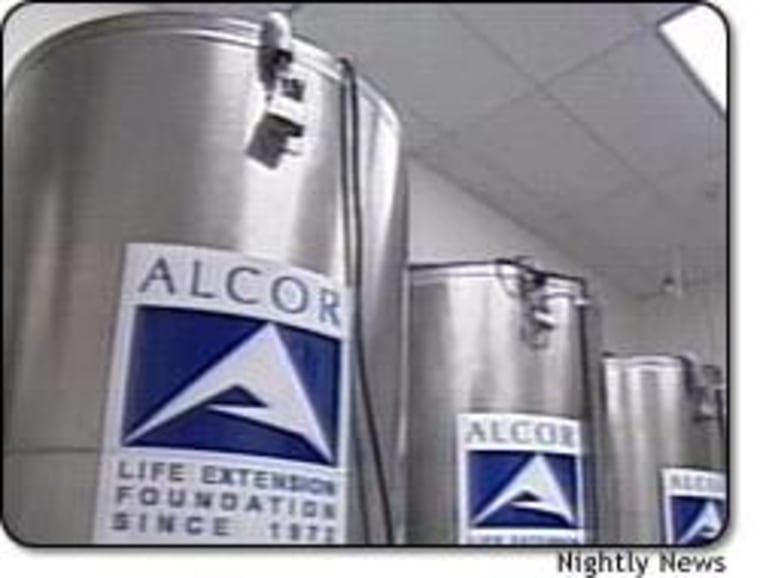Baseball great Ted Williams, the last man to hit .400 in a major-league season, has become the best-known figure to be frozen in expectation of a future revival, using as-yet unknown technologies.
Whether he stays frozen will depend on the courts. But the bizarre case has quickly stirred up quips about “the Frozen Splinter” as well as serious questions about cryonic suspension.
The Arizona concern that now houses Williams’ mortal remains, Alcor Life Extension Foundation, speculates that sometime in the next century or so, technological advances will allow their frozen “patients” to be revived at a cost equivalent to a $3 wristwatch. Alcor is currently tending about 50 patients, who have paid $120,000 for a whole-body freeze, or $50,000 for a head freeze. (In most cases, the fees are paid from life insurance, with Alcor putting the bulk of the payment into a trust fund.)
How it's done
Here’s how the procedure is done: After a declaration of death, the body is put on a heart-lung machine for transfer to the freezing facility. The body is cooled in an ice bath, the blood is replaced with a preservative solution, and as much water as possible is drawn out from the remains — so as to avoid cellular damage from ice crystals.
Then the body (or just the head) is cooled to around 320 degrees below zero Fahrenheit, using a liquid-nitrogen cryogenic system, and stored in a vacuum chamber until scientists figure out how to revive the body and repair the damage.
The longer you wait to start the process, the higher the chance of cell damage. Williams’ body was shipped from Florida to Arizona on Friday, the day he died, and the process had to have started after it arrived at Alcor. The full cooldown process takes seven to 14 days.
Is there any chance at all that this could work? Alcor and other proponents of cryonics say they expect scientists to develop nanoscale robots that could course through the bloodstream, repairing the cellular damage caused by post-death deterioration and the freezing process.
“I expect that in the coming decades we will develop medical technologies that quite literally will be able to deal with human tissue at the cellular and molecular level,” said Ralph Merkle, a nanotechnology theorist at Zyvex Corp. who also sits on Alcor’s board of directors.
Arthur Caplan, director of the University of Pennsylvania’s Center for Bioethics and an MSNBC.com columnist, says he agrees that tissue-repairing nanobots could become a reality someday — but he’s a “complete skeptic” when it comes to reviving the frozen dead.
“It’s one thing to repair a clogged artery (in a living organism) but it’s a very different thing to say I’m going to take this soupy glop and turn it into an 83-year-old retired baseball player,” he said.
Although frozen cell samples have been successfully revived, there’s a big difference between that and thawing out an integrated organic unit such as a body or a brain, Caplan said.
“You know how fragile brain cells are. ... It takes almost nothing to damage the brain irreversibly,” he pointed out. “I’d rather download the contents of my brain into a computer chip when that becomes possible.”
Merkle, however, maintained that hard-wired brain structures could conceivably survive the freeze and the thaw. He acknowledged that there was as yet no scientific evidence that Ted Williams or other frozen subjects could be revived intact. Nevertheless, he said, “my opinion is that it’s likely that cryonics will work” sometime in the future.
There’s plenty of time for technology to catch up, Merkle maintained. “Once you’re in liquid nitrogen, nothing changes,” he said. “There are no changes, for decades, centuries, even thousands of years. There’s no deadline, so to speak.”
Future clones?
Williams’ daughter, Bobby-Jo Ferrell, has said she suspects that her half-brother, John Henry Williams, had the baseball great’s body frozen principally to preserve the DNA for future cloning-for-hire. That seems unlikely, however, for a couple of reasons: First, there are far less expensive and far more reliable ways to preserve tissue samples for DNA purposes. And although Alcor isn’t releasing any details about the specific arrangements for Williams’ remains, the legal arrangements generally make the foundation responsible for safeguarding the remains until they can be revived. If just the head is preserved, Alcor would presumably wait until technology makes it possible to transfer the head or brain into a cloned body.
So unless Ferrell is successful and the courts order a premature thaw, Ted Williams seems destined to remain within a cryogenically cooled container for the foreseeable future, waiting for a highly unlikely revival and an unknown cure.
Even assuming that this becomes possible, would that future life be worth living? Merkle says yes: “Basically, either cryonics works or it doesn’t. ... If it works, you’ll be able, in the future, to see spectacular advances in technology (in a world) where people care about human beings.”
Caplan, however, holds an opposing view: “Metaphysically, if you come back from the dead after 200 or 500 years, you’re going to end up being nothing more than a freak.”
